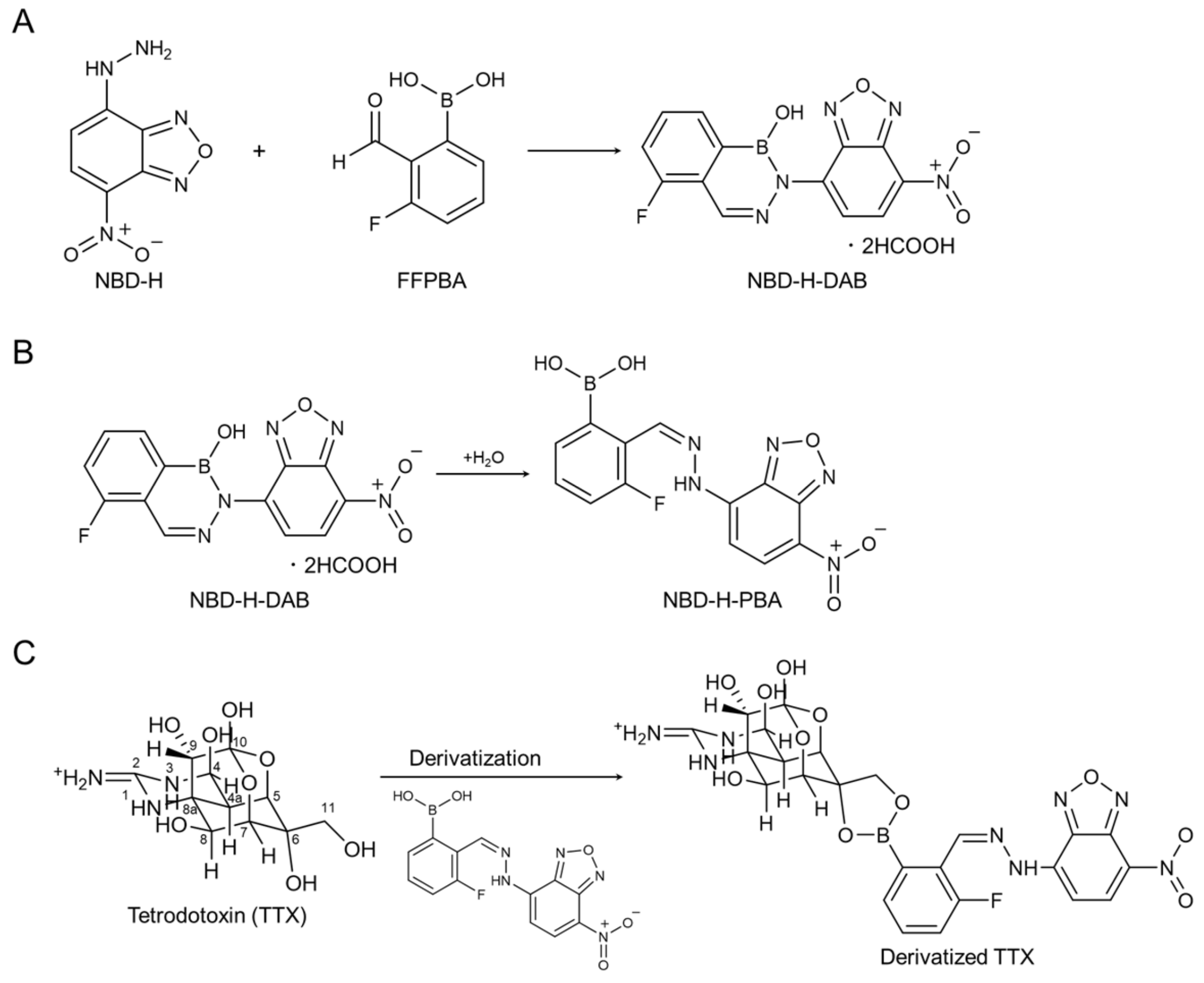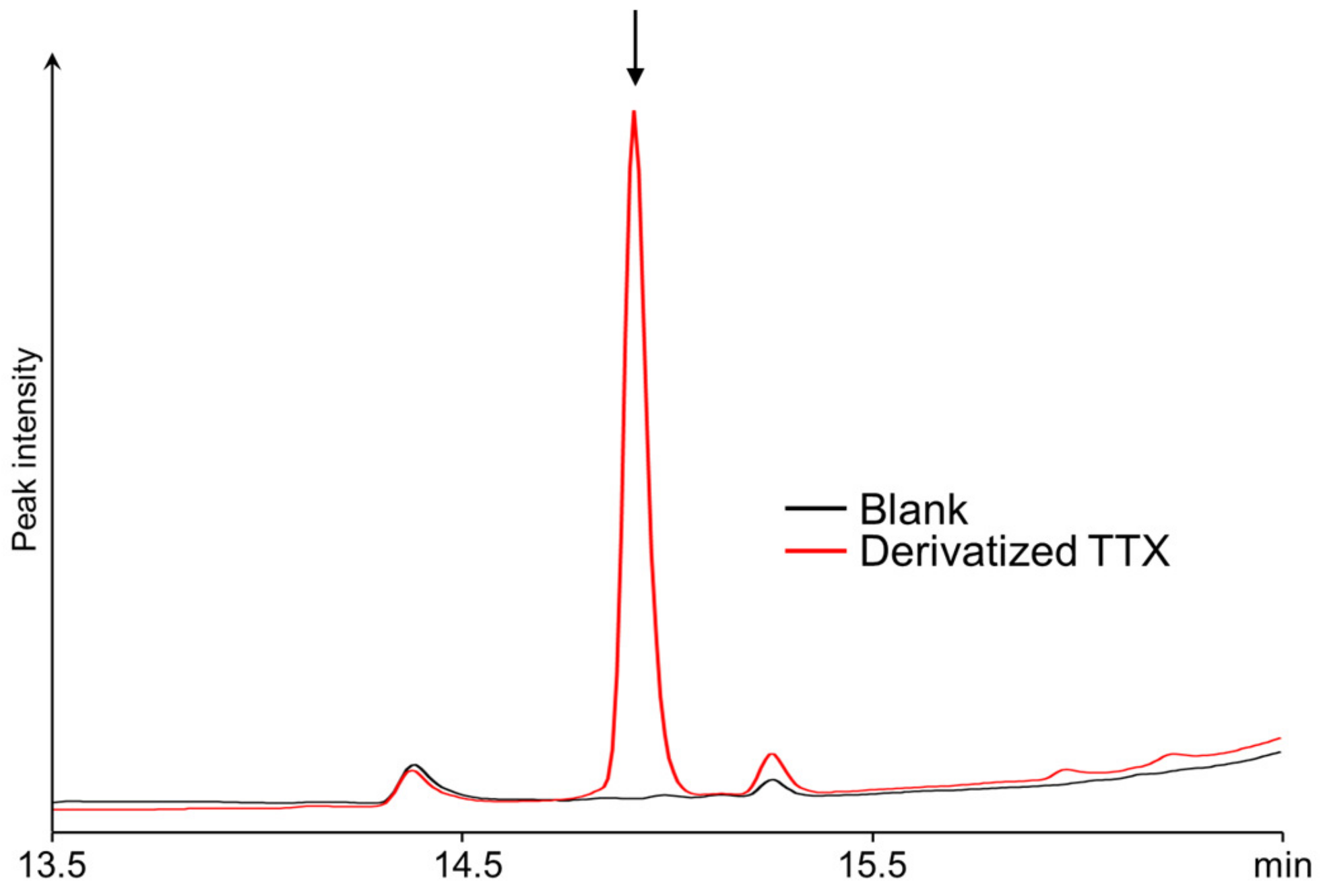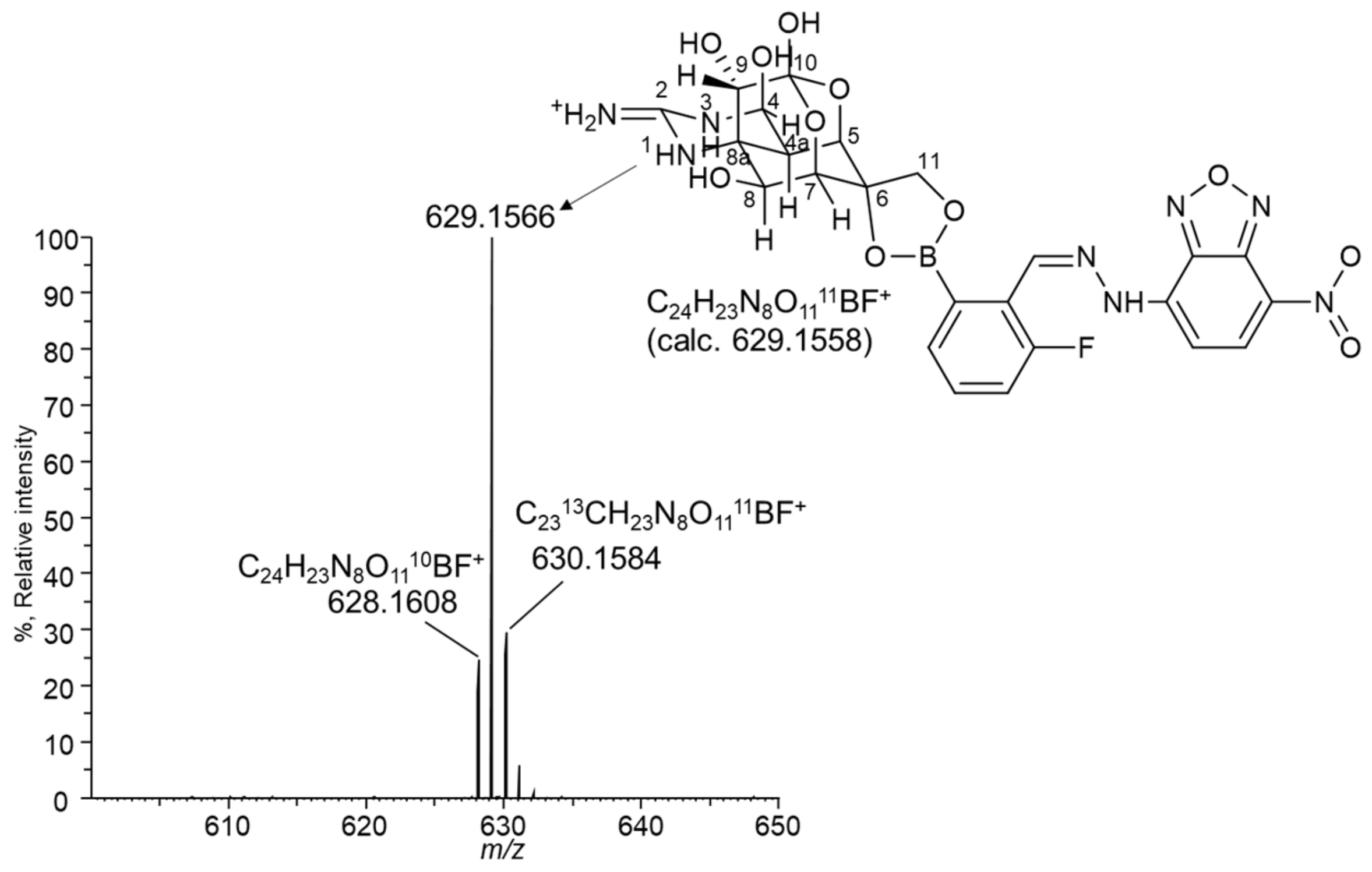Tetrodotoxin Derivatization with a Newly Designed Boron Reagent Leads to Conventional Reversed-Phase Liquid Chromatography
Abstract
:1. Introduction
2. Results and Discussion
2.1. Design of Derivatization Reagent
2.2. Optimization of Derivatization Conditions
2.3. Effects of the Derivatization of TTX and Structural Analysis
2.4. Analysis of Matrix Sample
3. Conclusions
4. Materials and Methods
4.1. Reagents and Materials
4.2. Synthesis of NBD-H-DAB
4.3. Confirmation of NBD-H-DAB and Derivatized Product of TTX with NBD-H-DAB
4.4. Sample Preparation from Fish Flesh
4.5. Derivatization Procedure
4.6. Instrumentation and LC–UV Conditions
Supplementary Materials
Author Contributions
Funding
Institutional Review Board Statement
Informed Consent Statement
Data Availability Statement
Acknowledgments
Conflicts of Interest
References
- Noguch, T.; Arakawa, O. Tetrodotoxin—Distribution and Accumulation in Aquatic Organisms, and Cases of Human Intoxication. Mar. Drugs 2008, 6, 220–242. [Google Scholar] [CrossRef]
- Lago, J.; Rodríguez, L.P.; Blanco, L.; Vieites, J.M.; Cabado, A.G. Tetrodotoxin, an Extremely Potent Marine Neurotoxin: Distribution, Toxicity, Origin and Therapeutical Uses. Mar. Drugs 2015, 13, 6384–6406. [Google Scholar] [CrossRef] [PubMed]
- Yasumoto, T.; Michishita, T. Fluorometric determination of tetrodotoxin by high performance liquid chromatography. Agric. Biol. Chem. 1985, 49, 3077–3080. [Google Scholar] [CrossRef]
- Yasumoto, T.; Nakamura, M.; Oshima, Y.; Takahata, J. Construction of a continuous tetrodotoxin analyzer. Bull. Jpn. Soc. Sci. Fish. 1982, 48, 1481–1483. [Google Scholar] [CrossRef]
- Leung, K.S.-Y.; Fong, B.M.-W.; Tsoi, Y.-K. Analytical Challenges: Determination of Tetrodotoxin in Human Urine and Plasma by LC-MS/MS. Mar. Drugs 2011, 9, 2291–2303. [Google Scholar] [CrossRef] [PubMed]
- Yasumoto, T.; Yotsu-Yamashita, M. Chemical and Etiological Studies on Tetrodotoxin and Its Analogs. J. Toxicol. Toxin Rev. 1996, 15, 81–90. [Google Scholar] [CrossRef]
- O’Leary, M.A.; Schneider, J.J.; Isbister, G.K. Use of high performance liquid chromatography to measure tetrodotoxin in serum and urine of poisoned patients. Toxicon 2004, 44, 549–553. [Google Scholar] [CrossRef] [PubMed]
- Yotsu, M.; Endo, A.; Yasumoto, T. An improved tetrodotoxin analyzer. Agric. Biol. Chem. 1989, 53, 893–895. [Google Scholar] [CrossRef]
- Shoji, Y.; Yotsu-Yamashita, M.; Miyazawa, T.; Yasumoto, T. Electrospray Ionization Mass Spectrometry of Tetrodotoxin and Its Analogs: Liquid Chromatography/Mass Spectrometry, Tandem Mass Spectrometry, and Liquid Chromatography/Tandem Mass Spectrometry. Anal. Biochem. 2001, 290, 10–17. [Google Scholar] [CrossRef] [PubMed]
- Kosker, A.R.; Özogul, F.; Durmus, M.; Ucar, Y.; Ayas, D.; Regenstein, J.M.; Özogul, Y. Tetrodotoxin levels in pufferfish (Lagocephalus sceleratus) caught in the Northeastern Mediterranean Sea. Food Chem. 2016, 210, 332–337. [Google Scholar] [CrossRef]
- Horie, M.; Kobayashi, S.; Shimizu, N.; Nakazawa, H. Determination of tetrodotoxin in puffer-fish by liquid chromatography-electrospray ionization mass spectrometry. Analyst 2002, 127, 755–759. [Google Scholar] [CrossRef] [PubMed]
- Fong, B.M.-W.; Tam, S.; Tsui, S.-H.; Leung, K.S.-Y. Development and validation of a high-throughput double solid phase extraction–liquid chromatography–tandem mass spectrometry method for the determination of tetrodotoxin in human urine and plasma. Talanta 2011, 83, 1030–1036. [Google Scholar] [CrossRef] [PubMed]
- Akaki, K.; Hatano, K. Determination of Tetrodotoxin in Puffer-fish Tissues, and in Serum and Urine of Intoxicated Humans by Liquid Chromatography with Tandem Mass Spectrometry. J. Food Hyg. Soc. Jpn. (Shokuhin Eiseigaku Zasshi) 2006, 47, 46–50. [Google Scholar] [CrossRef] [PubMed]
- Nakagawa, T.; Jang, J.; Yotsu-Yamashita, M. Hydrophilic interaction liquid chromatography–electrospray ionization mass spectrometry of tetrodotoxin and its analogs. Anal. Biochem. 2006, 352, 142–144. [Google Scholar] [CrossRef] [PubMed]
- Rodríguez, P.; Alfonso, A.; Otero, P.; Katikou, P.; Georgantelis, D.; Botana, L.M. Liquid chromatography–mass spectrometry method to detect Tetrodotoxin and Its analogues in the puffer fish Lagocephalus sceleratus (Gmelin, 1789) from European waters. Food Chem. 2012, 132, 1103–1111. [Google Scholar] [CrossRef]
- Oshiro, N.; Kuniyoshi, K.; Yamamoto, S.; Hotta, A.; Yamada, T.; Suzuki, T.; Sugita, N.; Matsuura, K.; Nakashima, A.; Anzai, Y.; et al. High Levels of Tetrodotoxin in the Flesh, Usually an Edible Part of the Pufferfish Takifugu flavipterus, Caused by Migration from the Skin and the Regional Characteristics of Toxin Accumulation. J. Mar. Sci. Eng. 2021, 9, 1312. [Google Scholar] [CrossRef]
- Turner, A.D.; Boundy, M.J.; Rapkova, M.D. Development and Single-Laboratory Validation of a Liquid Chromatography Tandem Mass Spectrometry Method for Quantitation of Tetrodotoxin in Mussels and Oysters. J. AOAC Int. 2017, 100, 1469–1482. [Google Scholar] [CrossRef] [PubMed]
- Turner, A.D.; Dhanji-Rapkova, M.; Fong, S.Y.T.; Hungerford, J.; McNabb, P.S.; Boundy, M.J.; Harwood, D.T. Ultrahigh-Performance Hydrophilic Interaction Liquid Chromatography with Tandem Mass Spectrometry Method for the Determination of Paralytic Shellfish Toxins and Tetrodotoxin in Mussels, Oysters, Clams, Cockles, and Scallops: Collaborative Study. J. AOAC Int. 2020, 103, 533–562. [Google Scholar] [CrossRef] [PubMed]
- Tsujimura, K.; Yamanouchi, K. A rapid method for tetrodotoxin (TTX) determination by LC-MS/MS from small volumes of human serum, and confirmation of pufferfish poisoning by TTX monitoring. Food Addit. Contam. Part A 2015, 32, 977–983. [Google Scholar] [CrossRef] [PubMed]
- Saito, T.; Miura, N.; Namera, A.; Ota, S.; Miyazaki, S.; Inokuchi, S. A Rapid Sample Preparation Procedure Using MonoSpin CBA and Amide Columns for Tetrodotoxin Detection in Serum and Urine Using LC–MS/MS Analysis. Chromatographia 2014, 77, 687–693. [Google Scholar] [CrossRef]
- van Nuijs, A.L.; Tarcomnicu, I.; Covaci, A. Application of hydrophilic interaction chromatography for the analysis of polar contaminants in food and environmental samples. J. Chromatogr. A 2011, 1218, 5964–5974. [Google Scholar] [CrossRef] [PubMed]
- Huo, F.; Wang, X.; Han, Y.; Bai, Y.; Zhang, W.; Yuan, H.; Liu, H. A new derivatization approach for the rapid and sensitive analysis of brassinosteroids by using ultra high performance liquid chromatography-electrospray ionization triple quadrupole mass spectrometry. Talanta 2012, 99, 420–425. [Google Scholar] [CrossRef] [PubMed]
- Miles, C.O.; Kilcoyne, J.; McCarron, P.; Giddings, S.D.; Waaler, T.; Rundberget, T.; Samdal, I.A.; Løvberg, K.E. Selective Extraction and Purification of Azaspiracids from Blue Mussels (Mytilus edulis) Using Boric Acid Gel. J. Agric. Food Chem. 2018, 66, 2962–2969. [Google Scholar] [CrossRef] [PubMed]
- Mudge, E.M.; Robertson, A.; McCarron, P.; Miles, C.O. Selective and Efficient Capture and Release of vic-Diol-Containing Pacific and Caribbean Ciguatoxins from Fish Extracts with a Boronate Affinity Polymer. J. Agric. Food Chem. 2022, 70, 12946–12952. [Google Scholar] [CrossRef] [PubMed]
- Beach, D.; Kerrin, E.; McCarron, P.; Kilcoyne, J.; Giddings, S.; Waaler, T.; Rundberget, T.; Samdal, I.; Lovberg, K.; Miles, C. Boronate techniques for clean-up and concentration of the vic-diol-containing tetrodotoxins from shellfish. In Proceedings of the 18th International Conference on Harmful Algae, Hobart, Australia, 7–11 February 2000; Hess, P., Ed.; International Society for the Study of Harmful Algae: Nante, France, 2020; pp. 125–128. [Google Scholar]
- Bernardini, R.; Oliva, A.; Paganelli, A.; Menta, E.; Grugni, M.; De Munari, S.; Goldoni, L. Stability of Boronic Esters to Hydrolysis: A Comparative Study. Chem. Lett. 2009, 38, 750–751. [Google Scholar] [CrossRef]
- Liu, Z.; He, H. Synthesis and Applications of Boronate Affinity Materials: From Class Selectivity to Biomimetic Specificity. Acc. Chem. Res. 2017, 50, 2185–2193. [Google Scholar] [CrossRef] [PubMed]
- Gu, H.; Chio, T.I.; Lei, Z.; Staples, R.J.; Hirschi, J.S.; Bane, S. Formation of hydrazones and stabilized boron–nitrogen heterocycles in aqueous solution from carbohydrazides and ortho-formylphenylboronic acids. Org. Biomol. Chem. 2017, 15, 7543–7548. [Google Scholar] [CrossRef] [PubMed]
- António, J.P.M.; Gonçalves, L.M.; Guedes, R.C.; Moreira, R.; Gois, P.M.P. Diazaborines as New Inhibitors of Human Neutrophil Elastase. ACS Omega 2018, 3, 7418–7423. [Google Scholar] [CrossRef] [PubMed]
- Goto, T.; Kishi, Y.; Takahashi, S.; Hirata, Y. Tetrodotoxin. Tetrahedron 1965, 21, 2059–2088. [Google Scholar] [CrossRef] [PubMed]
- Wu, X.; Li, Z.; Chen, X.-X.; Fossey, J.S.; James, T.D.; Jiang, Y.-B. Selective sensing of saccharides using simple boronic acids and their aggregates. Chem. Soc. Rev. 2013, 42, 8032–8048. [Google Scholar] [CrossRef]
- Groleau, R.R.; Chapman, R.S.L.; Ley-Smith, H.; Liu, L.; James, T.D.; Bull, S.D. A Three-Component Derivatization Protocol for Determining the Enantiopurity of Sulfinamides by 1H and 19F NMR Spectroscopy. J. Org. Chem. 2020, 85, 1208–1215. [Google Scholar] [CrossRef] [PubMed]
- Rey, V.; Botana, A.M.; Alvarez, M.; Antelo, A.; Botana, L.M. Liquid Chromatography with a Fluorimetric Detection Method for Analysis of Paralytic Shellfish Toxins and Tetrodotoxin Based on a Porous Graphitic Carbon Column. Toxins 2016, 8, 196. [Google Scholar] [CrossRef] [PubMed]





| HPLC | Equipment | Vanquish UHPLC System (Thermo Scientific) |
|---|---|---|
| Column | Zorbax Eclipse Plus C18 (1.8 µm, 2.1 × 50 mm, Agilent Technologies, Santa Clara, CA, USA) | |
| Column temperature | 40 °C | |
| Injection volume | 5 µL | |
| Solvent A | 5 mM Ammonium formate in 0.1% Formic acid | |
| Solvent B | Formic acid and 5 mM ammonium formate in 90% (v/v) CH3CN (0.1:99.9, v/v) | |
| Flow rate | 0.4 mL/min | |
| Gradient condition | 0–5 min: 10% B, 5–10 min: 10 → 100% B, 10–15 min → 100% B, 15–20 min: 10% B | |
| MS | Equipment | Q-Exactive Plus Orbitrap (Thermo Scientific) |
| Ionization | heated electrospray ionization (HESI) | |
| Spray voltage | 3.5 kV | |
| Auxiliary gas | 450 °C, 15 L/min | |
| Sheath gas | 50 L/min | |
| Capillary temperature | 300 °C | |
| Collision energy | 30 and 50 eV | |
| Resolution | 17,500 | |
| AGC target | 3e6 | |
| Maximum IT | 200 ms | |
| Scan ranges | m/z 100–1000 | |
| MS/MS | Spray voltage | 3.5 kV |
| Auxiliary gas | 450 °C, 15 L/min | |
| Sheath gas | 50 L/min | |
| Capillary temperature | 300 °C | |
| Collision energy | 30 and 50 eV | |
| Resolution | 17,500 | |
| AGC target | 2e5 | |
| Maximum IT | 100 ms | |
| Precursor | TTX: 320.10884, derivatized TTX: 629.15579 |
Disclaimer/Publisher’s Note: The statements, opinions and data contained in all publications are solely those of the individual author(s) and contributor(s) and not of MDPI and/or the editor(s). MDPI and/or the editor(s) disclaim responsibility for any injury to people or property resulting from any ideas, methods, instructions or products referred to in the content. |
© 2024 by the authors. Licensee MDPI, Basel, Switzerland. This article is an open access article distributed under the terms and conditions of the Creative Commons Attribution (CC BY) license (https://creativecommons.org/licenses/by/4.0/).
Share and Cite
Kawasue, S.; Kuniyoshi, K.; Uema, M.; Oshiro, N. Tetrodotoxin Derivatization with a Newly Designed Boron Reagent Leads to Conventional Reversed-Phase Liquid Chromatography. Toxins 2024, 16, 260. https://doi.org/10.3390/toxins16060260
Kawasue S, Kuniyoshi K, Uema M, Oshiro N. Tetrodotoxin Derivatization with a Newly Designed Boron Reagent Leads to Conventional Reversed-Phase Liquid Chromatography. Toxins. 2024; 16(6):260. https://doi.org/10.3390/toxins16060260
Chicago/Turabian StyleKawasue, Shimba, Kyoko Kuniyoshi, Masashi Uema, and Naomasa Oshiro. 2024. "Tetrodotoxin Derivatization with a Newly Designed Boron Reagent Leads to Conventional Reversed-Phase Liquid Chromatography" Toxins 16, no. 6: 260. https://doi.org/10.3390/toxins16060260





